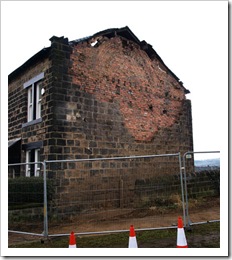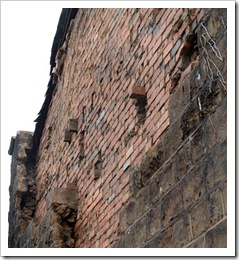Wall ties are critical to any building with a cavity wall. It doesn’t matter if the wall is a traditional cavity or a rubble filled, pseudo solid wall.
This is an example of what happens when wall ties are lacking. The gable end of this house suffered catastrophic collapse of the gable in high winds (last Friday) – there were no previous signs of a problem – no bulging or cracking.
The house has a brick inner skin, with an external skin of 300mm thick stone. The cavity between is filled with a loose rubble.
As can be seen in the image, a few ‘through stones’ were present; built into the inner brick skin.
Several tonnes of stone, including the chimney,collapsed onto a path adjacent to a busy road and the lack of ties resulted in the top half of the gable just ‘peeling away’ with the chimney.
We were called in by the Insurer’s structural engineers and our guys are tasked with stabilising the remaining stone areas and installing a grid of ‘starter’ ties for the mason to build up to. We’re also taking the opportunity to install lateral restraints into the floors and roof structure, to add modern levels of restraint to this exposed gable.
Unfortunately the insurer’s involvement is now at an end – seems this is all due to ‘general wear and tear’ and ‘lack of proper maintenance’. That’s alright then.
The moral of the storey is, get a decent survey done before purchase and if there is any suggestion of a wall tie problem – corrosion or lack of ties, then get the job done, you cannot rely on insurance to bail you out.
Mortgage lenders should take note too. The lip service currently paid to wall tie problems will bite them in the arse, should anyone be killed or injured and it be subsequently shown that they merely ‘recommended’ that the ties be checked; allowing estate agents and intermediaries to gloss over the problem. Home buyers should be expressly warned about the potential consequences of ignoring wall tie restraint.
They don’t build ‘em like they used to.
Dry Rot

